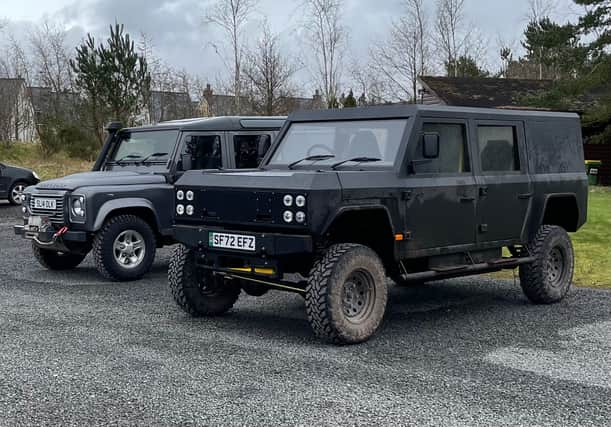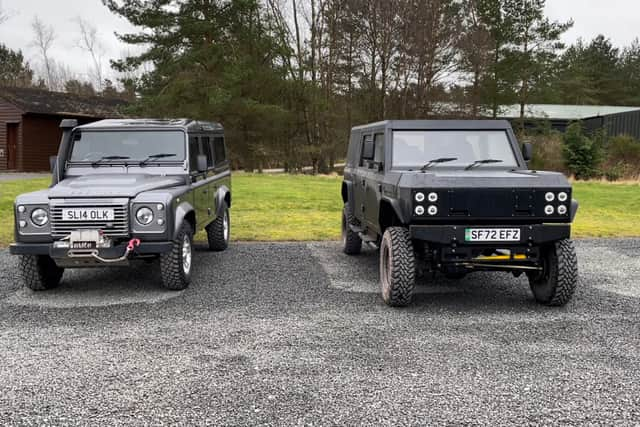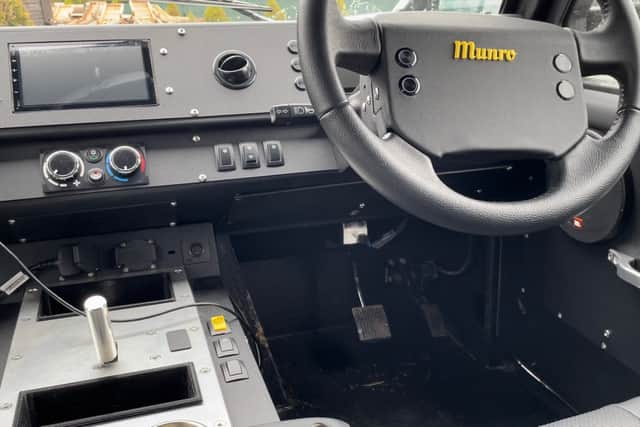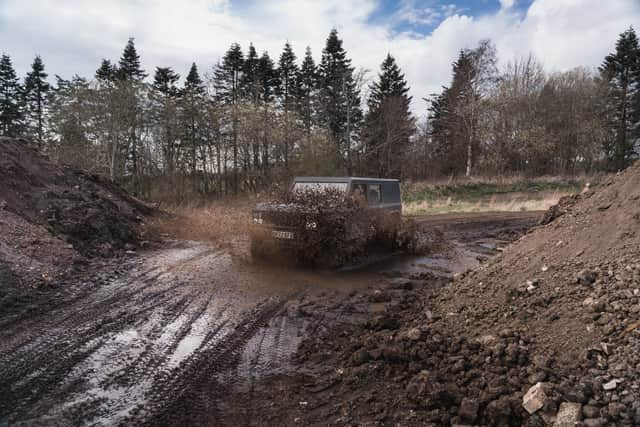Munro Mk_1: the Scottish-built EV the founders hope will change the way we buy off-roaders


Proof that designing a car with nothing but a set-square doesn’t have to result in something as unappealing as Tesla’s Cybertruck, the Mk_1 from Scottish EV start-up Munro could be set to change the landscape of off-road motoring for the better.
CEO and Co-founder Russell Peterson hopes the Land Rover Defender’s move upmarket and the pressure on fleet managers to decarbonise their fleets will create fertile ground for the agriculture, industrial and response targeted Munro Mk_1.
Munro Mk_1: What is it and do the stats stack up?
Advertisement
Hide AdAdvertisement
Hide AdDesigned from the ground-up as a pure-bred off-road utility vehicle, the Munro Mk_1 has permanent mechanical four-wheel drive and joins a 61kWh battery and 220kW Axial Flux motor to a pair of live axles via a two-speed transmission. In higher specification the battery can be upgraded to 82 kWh and the motor 280kw.
The Mk_1 sits high, which means approach and departure angles of 84 and 51 degrees respectively are achieved as well as a 148-degree breakover angle. For context, the highly impressive Land Rover Defender has an approach angle of 37.5 degrees and a departure angle of 40 degrees when specified with the optional air suspension instead of coil springs.


Range is relatively modest by modern standards - 141 miles or 190 miles, depending on which version you opt for. The more relevant statistic, say Munro, is 16 plus hours of continuous off-road driving.
It can tow 2,500kg braked or 750kg unbraked and take a payload of up to 1,000kg with a maximum gross weight of 3,500kg, qualifying the Mk_1, crucially, in the light-commercial vehicle class. Damage-resistant Raptor paint and a long list of customiseable options only begin to round out the list of ways the team at Munro has thought about the needs of specialist buyers.
Advertisement
Hide AdAdvertisement
Hide AdIt wasn’t always this way though, Munro can trace its roots back to a camping trip at Braemar and an idea to deliver something quite different.
From leisure-targeted classic conversions to purpose-built specialist 4x4
“So when we started, it was going to be an electric version of a classic Defender, but when we looked into the cost to convert and the ability to get a good supply of those kinds of vehicles it was very, very difficult,” explains Russell Peterson, who co-founded Munro alongside Ross Anderson.
“So the next situation was: ‘ok, we want to do something that’s more our own design, but we’re not quite ready to completely make our own vehicle’”. That led to conversations with Rotherham-based 4x4 specialist Ibex which, ultimately, spawned the Munro EV prototype.
The Mk_1, however, is entirely designed and built in-house. The pivot toward industry, rather than the leisure sector, has been driven by market demand.
Advertisement
Hide AdAdvertisement
Hide Ad“The interesting thing behind our pivot towards commercial is, not that we aspired to do that, but actually there was a huge appetite for it. They sought us out and they came to us and said: ‘look, we’ve got fleets of 4x4s and we like what you’re doing. Is there any chance you can make a commercial version?’
“Those conversations just kept coming and coming and coming and coming, for 18 months, non stop. It was just every person that rang up and emailed us saying: ‘I’ve got a fleet, I’m having problems decarbonising my fleet because I’ve got electric vans, I’ve got electric cars, no electric 4x4s.


“We saw that we could make a huge impact on C02 that way and grow a really sustainable business. These fleet operators don’t just convert their whole fleet to electric overnight, they do it over a period of five or ten years and that’s really good for us because we can plan well into the future.”
As the potential in the market became apparent, Munro consulted directly with fleet managers and potential customers in the development of the Mk_1: “We look at utility companies, for example. They buy pick-up trucks or 4x4s in the tens or twenties or fifties, but they have huge capital outlay for those vehicles that turn up on site and they’re not ready for work.
Advertisement
Hide AdAdvertisement
Hide Ad“They then have to go to a customisation company. So if you’re replacing a fleet of customised vehicles over the next three or four years, you’re going to have to go through all of that to go electric. We think we can integrate some of that in our production line.”
Take the example of leasing companies catering to the utility sector, says Russell: “One of the leasing companies told me they supply pick-up trucks into utility companies and every time they get a pick-up truck, they have to take the back off it, and put a tool-box on the back.
“They’ve got a yard in England and it’s just stacks and stacks of brand-new pick-up bodies and - no one wants to buy one. So you’ve got all these bright blue pick-up beds that nobody needs, just sitting in a yard somewhere. That perfectly encapsulates what we’re trying to avoid.
“If you don’t need the back, we’ll just not build the back, you know what I mean?”
Advertisement
Hide AdAdvertisement
Hide AdDelivering specialist capability - at scale - to industry is where the team at Munro feel they can deliver change.
“We’ve had hundreds and hundreds of hours - 250 or 300 - of one-on-one interviews with fleet managers, not from a sales point of view, but from a product design point of view where we’re like: ‘Tell us your pain points, tell us what you’re trying to achieve here. Is it just an electric version of what we’ve got or is it more?’”


Visit the Munro website and you’ll see a sales pitch geared toward land management, infrastructure, industry and emergency services. That covers a lot of ground, each one a sector where specialist requirements of buyers might otherwise rule out electrification.
“We were speaking to a number of police forces but not as pursuit vehicles but as specialist (vehicles)," adds Russell. “They’ve got things like drone divisions where they’ve got a pick up truck with road tyres on it and we think, come on now, I think we can do a bit better than that.”
Advertisement
Hide AdAdvertisement
Hide AdThe level of customisation Munro is willing to consider for potential clients is something major providers have historically made difficult, says Russell: “All these things which, when they go to their fleet providers or sales providers or original OAMs and ask for, it’s like a huge ask, but for us it’s a given that the vehicle will come with that kind of thing.”
Off-road applications for emergency services and the armed forces has traditionally been Land Rover Defender territory, but as Jaguar Land Rover pursues a luxury strategy a gap has opened up for brands like Munro.
“Police, specialist forces - we’re looking at feasibility at supplying into limited military applications - and also mountain rescue. We have some really good inroads into mountain rescue. Our consultant off-road instructor trains most of the mountain rescue in Scotland and we work with him to understand what their requirements are.
“From a product design point of view we started working with Hugh (Roberts) before we even built the first prototype. Straight from day one we were like: ‘Tell us what the pain points are, tell us how we can build a vehicle that ultimately those petrol heads are going to want to give up their Defenders for’.”
Advertisement
Hide AdAdvertisement
Hide AdDespite the pivot towards industry and more specialist use cases, it’s still perfectly feasible that an enthusiast might in a few years time decide to swap out their Defender or Land Cruiser in favour of an all-electric Munro Mk_1. After all, Arnold Schwarzenegger was pottering about LA in his Humvee back when they only made vehicles for the military. Capability breeds desirability.
To Russell then, the leisure segment is still very much in his sights: “The B2B stuff becomes our bread and butter - but it doesn’t mean that we’ve given up on B2C. We do take orders and we are going to be building vehicles for the enthusiast market and the lifestyle market and I think you quite rightly picked up that the longer range version is more suited to that lifestyle customer.”
Creating a circular economy and maximum return on carbon investment
If Munro can become a major supplier to industry, then the Scottish start-up’s approach to sustainability, as well as powertrains, could make a significant impact on sustainability in the light commercial market. The antithesis to a model that sees hundreds of unused pick-up body shells stacked like pringles in an English industrial estate, their focus on delivering ‘maximum return on carbon investment’ seeks to introduce a level of sustainability into the supply chain - something often overlooked in a segment that relies on rare Earth minerals.
So what does that mean in practice?
“I’ll be honest with you,” says Russell, “We don’t have a fixed plan of how that’s going to work.”
Advertisement
Hide AdAdvertisement
Hide Ad“It’s something we’re chatting with our early adopter customers and the simple question we’ve started asking them was: ‘Ok, you’ve told us you keep vehicles for five years, you may keep the Munro for seven years if it performs well. Would you like after seven years a brand-new Munro, or an in-life refurbishment that’s half the price?’.”
“All of them said we’d rather do an in-life refurbishment. Not just from a cost point of view, but from a carbon point of view as well. So now we’re looking into how we can deliver that. Because it helps keep us in the revenue stream for those customers. We’re not giving up on those customers or saying they must buy a brand-new vehicle. We get that touch-point with that customer after five to seven years. They come back, the vehicle gets refurbed.


“It’s hugely beneficial for everyone’s carbon credentials. It means that we can really plough quality into the vehicle knowing that it’s not just going to get sold off at auction in five years and eventually scrapped.
“Five years of heavy commercial use and the interior can be wrecked. But there might be elements of the interior that are good, or they might want a motor upgrade but there’s going to be residual value in some of the components that come off that vehicle. So if we are doing refurbishment, it gives us the opportunity to refresh the vehicle. It might require new seats or whatever, but we’ll have some stock that’s potentially good to go into other refurbished vehicles.
Advertisement
Hide AdAdvertisement
Hide Ad“It’s going to create this pool of second-life components that’s going to sit on our shelf and that’s going to be like a circular economy.”
Residual value then, long-time key factor in cracking the fleet market, is something Russell and the team at Munro look at differently.
“When Fleet managers look at a vehicle, they look at residual value and when they look at residual value of traditional vehicles, it’s very, very different to how to calculate the residual value of a vehicle like the Munro. So, this is why we’re looking at in-life servicing and a couple of other options like guaranteed buy backs - because we have a different way of calculating the residual value of the vehicle. Salvage wise, there’s a lot of residual value in each vehicle that we build.”
Scale of production and overseas markets
It’s a very different way of looking at things in an industry dominated by huge multinational manufacturer conglomerates, chain dealerships and PCP-finance incentives. How much of a dent can Munro, from their workshop in East Kilbride make in the coming years?
Advertisement
Hide AdAdvertisement
Hide Ad“I think our immediate goal is in the low hundreds. This isn’t a huge, huge operation. That’s still a difficult task to get to, from where we are now.
“We want to deliver vehicles to customers so that they can trial the vehicle, trust the vehicle, trust the brand and trust us as a company with a view to converting their wider fleets to Munros.
“The slightly longer-term goal, the five or ten-year goal is to get to the point where we’re manufacturing these in the low thousands, aiming for 2.5k, 3k vehicles a year, which I think from what we’ve looked at is going to be enough to keep up with private sector customers in the UK and in Europe, but I think if we do go towards more military or public sector I think we’re going to have to think about a separate facility for assembly.”
In terms of overseas markets outside of Europe, they’re working on it, says Russell: “We’re homologating the vehicle under small series type approval for both the UK and EU homologation. So we’ll have the ability and the vehicle will be considered roadworthy in the UK and the EU.
Advertisement
Hide AdAdvertisement
Hide Ad“We’re working on the US. It’s a different and difficult market. They have very interesting requirements but the plus point is if we break the US market and we’re able to satisfy all the US regulation, they pretty much have the highest road regulation in the world, so anywhere else that we want to go with the product and any other market we want to enter we’ll have a lot of the technology on the shelf.”
Comment Guidelines
National World encourages reader discussion on our stories. User feedback, insights and back-and-forth exchanges add a rich layer of context to reporting. Please review our Community Guidelines before commenting.
